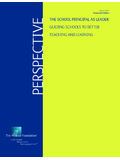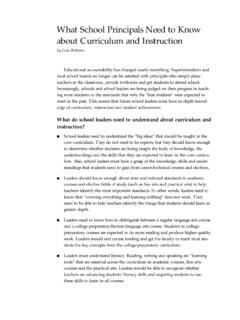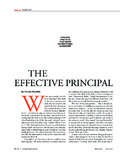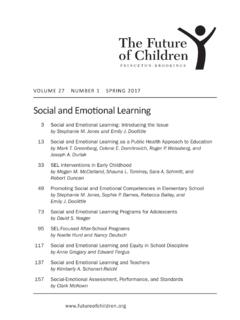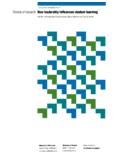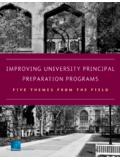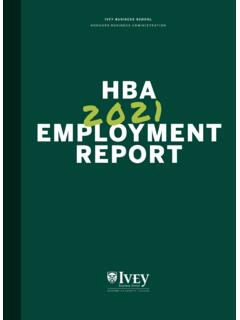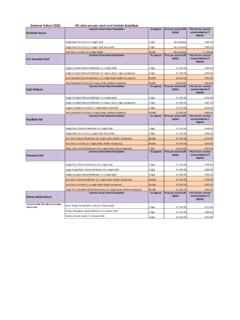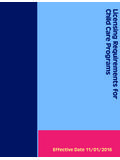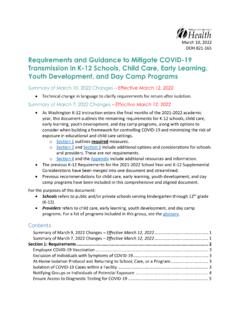Transcription of The Value of Out-of-School Time Programs
1 1 Youth (grades kindergarten through 12) across the United States participate in Out-of-School time (OST) Programs in group settings after school and during the summer . OST Programs can be multipurpose ( , after- school clubs, YMCA, Boys & Girls Club), academically oriented, or related to specialty interests ( , sports clubs, theater Programs ). These Programs are typically funded through a variety of mechanisms, including both public support ( , federal, state, and local grants) and private support ( , tuition, donations). Some OST Programs depend on multiple funding streams, typically a mixture of tuition paid by parents and grants. Programs that serve low-income youth rely on public funding to support operations, leading policymakers to legitimately ques-tion whether these Programs are a sound investment of public resources.
2 Advocates and critics alike can find evidence that supports or refutes the effectiveness of OST Programs . However, when effectiveness is considered, JENNIFER MCCOMBS, ANAMARIE WHITAKER, AND PAUL YOO The Value of Out-of-School time ProgramsCORPORATIONP erspectiveEXPERT INSIGHTS ON A TIMELY POLICY ISSUEKey Conclusions OST Programs provide measurable benefits to youth andfamilies on outcomes directly related to program content. Academic OST Programs can demonstrably improve aca-demic outcomes and do not necessarily reduce programatt endance at the elementary level. Program quality and intentionality influence outcomes. Youth need to attend regularly to measurably benefit are often grouped together without regard for differences among program goals ( , improve academic performance, promote positive social skills, or decrease substance use), content, or the measurable outcomes pro-gramming might produce.
3 Recently, OST funding at the federal level has come under scrutiny. The President s 2018 budget, while attempting to reduce the federal deficit, has proposed to eliminate the 21st Century Community Learning Centers (CCLC) grant, which is one of the largest funding sources that can be used for OST Programs (among other eligible activities). In addition, Child Care and Development Block Grants the other major federal funding source for OSTs would be held at fiscal 2016 spending levels. The result would be a dramatic reduction in federal funding that could be used for OST Programs . Proponents of the proposed cut to 21st CCLC funding cite program ineffectiveness in increasing academic performance.
4 However, this position is largely based on one evaluation and does not take into consideration program elements or other measures of ef-fectiveness unrelated to academic achievement. To better understand the Value and effectiveness of OST Programs , we examine Programs through the lenses of content, dosage (the hours of content provided), and outcomes measured, focusing on rigorous ( , experimental or quasi-experimental) large-scale evaluations and meta-analyses. Our overall conclusion is that OST Programs are generally effective at producing the primary outcomes that would be expected based on their content and design. However, the primary benefits of OST Programs are often understudied or underreported.
5 Based on our review, we consider these Programs worthy of continued public investment. We recommend that, when making funding decisions, federal, state, and local governments and private foundations consider all the benefits that Programs pro-vide to youth and families and emphasize program quality. We also encourage funders and researchers to measure outcomes aligned with program content. We start with a brief overview of the rationale for publicly funding OST Programs . We then outline a model linking different categories of OST Programs to likely outcomes before describing what we know about OST effectiveness through the lenses of content and dosage. We conclude with implications and recommendations for policymakers, funders, OST program leaders, and Invest Public Funds in OST?
6 Funding for OST Programs comes from families, founda-tions, corporations, and nonprofits, as well as from federal, Recommendations When making funding decisions, federal and state policy-makers should consider all benefits of Programs . Policymakers, private funders, and intermediaries shouldincentivize and support Out-of-School time providers ef-forts to develop intentional, high-quality Programs . Policymakers, private funders, and researchers should bet-ter catalog and assess the Value and quality of experiencesoff ered in OST Programs . Funders should expect and researchers should measureoutcomes that align with program content. Programs should work to maximize attendance of eachindividual , and local grants.
7 Overall, OST Programs are pri-marily funded through tuition and fees paid by families. However, public funding typically supports OST Programs that provide services to youth from low-income families. Public sources also provide the majority of funding for district or school -provided Programs for low-achieving students. This being the case, Programs serving a substan-tial percentage of youth from low-income families are far more likely to receive federal, state, and local grants than Programs serving youth from more affluent For instance, in a comprehensive review of one community s OST funding portfolio, federal and state funding streams provided 78 percent of funds for Programs serving low-income youth.
8 The remaining 21 percent came from the local United Way, philanthropy, and Even with public investment, there is unmet demand for high-quality Programs . A survey of parents estimates that million youth not currently in an after- school program would be enrolled in one if it were available to public s support for public investment in OST pro-grams is consistently high. Most recently, a 2017 opinion poll conducted by Quinnipiac University found 83 percent of those surveyed opposed cutting public funding for these This support has been fueled by three key factors (Figure 1). First, due to working family members, youth may be largely unsupervised after school , which increases their opportunities to engage in risky behaviors, such as drug use and unsafe sexual activity, and to become victims or perpetrators of Arguably, youth and community safety benefit by ensuring that youth have ac-cess to enriching activities, safe places, and caring adults when out of school .
9 FIGURE 1 Public support for OST Programs has been fueled by three key Programs provide cumulative opportunities to a After school ,unsupervised kidsmay engage in Youth access toenrichment activities ishighly dependent onfamily Low-income studentstrail substantiallybehind more-affluentpeers, in terms ofacademic , youth access to enrichment activities ( , arts, sports, music, theater, or other types of activities not necessarily related to increasing academic performance) is highly dependent upon family income. The highest-in-come families spend almost seven times more on enrich-ment activities for their children,6 and this spending gap creates an opportunity gap. For instance, approximately 59 percent of school -aged children from low-income families participate in sports, compared with 84 percent of children from wealthier families those with annual incomes of $75,000 or This opportunity gap exists for private lessons and participation in specialized clubs as well.
10 We should not just worry about the gap in terms of access; we should also be concerned about outcomes. Enrichment activities help build human and cultural capital and develop and define children s interests and skills. As noted in the Foundations of Young Adult Success framework, high-quality interactions or developmental experiences with peers and adults allow youth to foster skills and develop self-management strategies, including By participating in activities otherwise not readily available to them, low-income youth have access to new and enriching experiences that may provide lasting developmental benefits. Third, on average, low-income students trail substantially behind their more-affluent peers in terms of academic achievement on state and national assessments.
